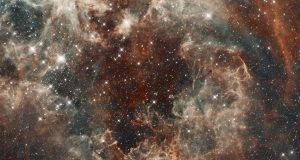
The Tarantula Nebula in the Large Magellanic Cloud. (Credit: NASA, ESA, ESO, D. Lennon (ESA/STScI), and the Hubble Heritage Team (STScI/AURA))
Space is getting crowded, so the recent launch of a space glitterball (called the “Humanity Star”) by RocketLabs has irked astronomers. Our suggestion: why not go and look at the space station instead? And if you’re interested in things to not get too hyped up about, the so-called “Super Blue Blood Moon” was another example – we have suggestions on what to do if you want to see such an event (spoiler: wait for the next lunar eclipse, or just go and look at the Moon at any time…).
There’s also been a slight anomaly during a launch the normally-reputable Ariane 5 rocket [Update: the issue now appears to be due to a software issue], and some new results about the seven-planet system TRAPPIST-1 (which we covered back in March last year)
An interesting result published earlier this month was the discovery that may be more massive stars than we previously thought. With impacts on the expected number of supernovae, neutron stars and black holes there might be out there to find, the effects could be far-reaching. Find out from University of Oxford’s Dr Fabian Schneider what this result means.
An extended edition of original broadcasts on 31st January 2018 as part of Pythagoras’ Trousers on Radio Cardiff.
Don’t forget you can now subscribe to the podcast. For an archive of Pythagorean Astronomy, visit pythagastro.uk.





